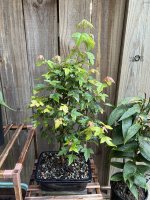Those moisture meters are designed to be reasonably accurate in garden soil but they can't read the coarse particles and larger spaces in bonsai soil accurately and usually read much drier than it actually is. More accurate to use your finger or a wooden chopstick or skewer.
How often to water depends on a whole range of factors - how much sun, daily temps, soil type, pot size, tree size, species, ambient humidity, etc, etc. I water twice a day through most of Summer but that's with daytime temps close to 100F, humidity in the teens and relatively open soil mix. Many people can get away with once a day but much better to test the soil before watering.
If in doubt, remember that a tree can die from underwatering in a few hours. It takes weeks and weeks of overwatering to kill a tree.
I'm struggling a bit with my outdoor trident maple. It has a lot of droopy and yellow/red leaves.
I'm not seeing droopy leaves in the photo.
Red leaves at the tips is normal. Most trident maple leaves open up reddish but soon change to green as the leaves mature.
New leaves also tend to hang down until they start to harden up so that may be what's making you think droopy? If you see the last section of the branch hanging down that's droopy from dehydration and needs quick attention.
The yellow leaves are cause for concern. Yellow leaves is typical of nutrient deficiency. Yellow can indicate Nitrogen, Iron, Magnesium or Manganese deficiency. Yellow leaves with green veins is called chlorosis. If it's in older leaves it usually means Nitrogen or Magnesium because plants can take those nutrients from older leaves and give to the new ones. Healthy older leaves but newer leaves affected means Iron or Manganese because they cannot be moved from older tissues.
As it appears to be younger leaves affected it is very likely your plant is showing Iron deficiency. That can be cause in 2 different ways - 1. Alkaline soil means available Iron cannot be absorbed by the roots, 2. Not enough Iron in the soil.
1 is the most common. Most tap water is adjusted to be alkaline so the water doesn't corrode pipes. The alkaline water makes the soil alkaline and plants can't get at the Iron in your fertiliser.
Treatment: Try chelated iron as directed on the pack. It has iron but is also slightly acid to help balance the soil.
Longer term, try using an acidifying fertiliser like Miracid which feeds the plant and also helps adjust soil acidity.
If you haven't been fertilising regularly you should start. Frequent watering washes nutrients out of the pot so we need to add fertiliser much more regularly than most other gardening.


